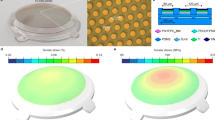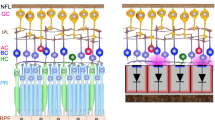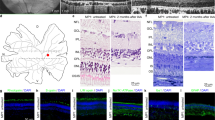Abstract
Retinal degenerative diseases lead to blindness due to loss of the ‘image capturing’ photoreceptors, while neurons in the ‘image-processing’ inner retinal layers are relatively well preserved. Electronic retinal prostheses seek to restore sight by electrically stimulating the surviving neurons. Most implants are powered through inductive coils, requiring complex surgical methods to implant the coil-decoder-cable-array systems that deliver energy to stimulating electrodes via intraocular cables. We present a photovoltaic subretinal prosthesis, in which silicon photodiodes in each pixel receive power and data directly through pulsed near-infrared illumination and electrically stimulate neurons. Stimulation is produced in normal and degenerate rat retinas, with pulse durations of 0.5–4 ms, and threshold peak irradiances of 0.2–10 mW mm−2, two orders of magnitude below the ocular safety limit. Neural responses were elicited by illuminating a single 70 µm bipolar pixel, demonstrating the possibility of a fully integrated photovoltaic retinal prosthesis with high pixel density.
This is a preview of subscription content, access via your institution
Access options
Subscribe to this journal
Receive 12 print issues and online access
$209.00 per year
only $17.42 per issue
Buy this article
- Purchase on Springer Link
- Instant access to full article PDF
Prices may be subject to local taxes which are calculated during checkout






Similar content being viewed by others
Change history
16 November 2012
A relevant publication on the topic of the flexible substrate concept applied to a retinal implant should have been cited in this Article. The publication is by Dinyari, R., Loudin, J. D., Huie, P., Palanker, D. & Peumans, P. and is entitled "A Curvable silicon retinal implant" published in International Electron Devices Meeting (IEDM) (IEEE International, 2009). It is now cited as reference 39 in the Article. Additionally, Fig. S4a in the Supplementary Information of the Article is reproduced from the same new reference, with permission from IEEE. These revisions have been made in HTML and PDF versions of the Article, and PDF version of the Supplementary Information.
References
Smith, W. et al. Risk factors for age-related macular degeneration: pooled findings from three continents. Ophthalmology 108, 697–704 (2001).
Haim, M. Epidemiology of retinitis pigmentosa in Denmark. Acta Ophthalmol. Scand. (Suppl) 233, 1–34 (2002).
Kim, S. Y. et al. Morphometric analysis of the macula in eyes with disciform age-related macular degeneration. Retina 22, 471–477 (2002).
Mazzoni, F., Novelli, E. & Strettoi, E. Retinal ganglion cells survive and maintain normal dendritic morphology in a mouse model of inherited photoreceptor degeneration. J. Neurosci. 28, 14282–14292 (2008).
Stone, J. L., Barlow, W. E., Humayun, M. S., de Juan, E. Jr & Milam, A. H. Morphometric analysis of macular photoreceptors and ganglion cells in retinas with retinitis pigmentosa. Arch. Ophthalmol. 110, 1634–1639 (1992).
Ahuja, A. K. et al. Blind subjects implanted with the Argus II retinal prosthesis are able to improve performance in a spatial-motor task. Br. J. Ophthalmol. 95, 539–543 (2010).
Zrenner, E. et al. Subretinal electronic chips allow blind patients to read letters and combine them to words. Proc. R. Soc. B 278, 1489–1497 (2010).
Besch, D. et al. Extraocular surgery for implantation of an active subretinal visual prosthesis with external connections: feasibility and outcome in seven patients. Br. J. Ophthalmol. 92, 1361–1368 (2008).
DeMarco, P. et al. Stimulation via a subretinally placed prosthetic elicits central activity and induces a trophic effect on visual responses. Invest. Ophthalmol. Vis. Sci. 48, 916–926 (2007).
Pardue, M. et al. Possible sources of neuroprotection following subretinal silicon chip implantation in RCS rats. J. Neural Eng. 2, S39–S47 (2005).
Bourne, M. C., Campbell, D. A. & Tansley, K. Hereditary degeneration of the rat retina. Br. J. Ophthalmol. 22, 613–623 (1938).
Loudin, J. D. et al. Optoelectronic retinal prosthesis: system design and performance. J. Neural Eng. 4, S72–S84 (2007).
Palanker, D. V. et al. Design of a high-resolution optoelectronic retinal prosthesis. J. Neural Eng. 2, S105–S120 (2005).
Stelzle, M., Stett, A., Brunner, B., Graf, M. & Nisch, W. Electrical properties of micro-photodiode arrays for use as artificial retina implant. Biomed. Microdev. 3, 133–142 (2001).
Brummer, S. B. & Turner, M. J. Electrical-stimulation of nervous-system—principle of safe charge injection with noble-metal electrodes. Bioelectrochem. Bioenerg. 2, 13–25 (1975).
Cogan, S. F., Guzelian, A. A., Agnew, W. F., Yuen, T. G. & McCreery, D. B. Over-pulsing degrades activated iridium oxide films used for intracortical neural stimulation. J. Neurosci. Methods 137, 141–150 (2004).
Active Implantable Medical Devices, in Directive 90/385/EEC; available at http://ec.europa.eu/enterprise/policies/european-standards/harmonised-standards/implantable-medical-devices/ (2004).
Loudin, J., Cogan, S., Mathieson, K., Sher, A. & Palanker, D. Photodiode circuits for retinal prostheses. IEEE Trans. Biomed. Circ. Syst. 5, 468–480 (2011).
Chow, A. et al. The artificial silicon retina microchip for the treatment of vision loss from retinitis pigmentosa. Arch. Ophthalmol. 122, 460–469 (2004).
Beebe, X. & Rose, T. Charge injection limits of activated iridium oxide electrodes with 0.2 ms pulses in bicarbonate buffered saline (neurological stimulation application). IEEE Trans. Biomed. Eng. 35, 494–495 (1988).
Cogan, S., Troyk, P., Ehrlich, J., Plante, T. & Detlefsen, D. Potential-biased, asymmetric waveforms for charge-injection with activated iridium oxide (AIROF) neural stimulation electrodes. IEEE Trans. Biomed. Eng. 53, 327–332 (2006).
Negi, S., Bhandari, R., Rieth, L., Van Wagenen, R. & Solzbacher, F. Neural electrode degradation from continuous electrical stimulation: comparison of sputtered and activated iridium oxide. J. Neurosci. Methods 186, 8–17 (2010).
Green, M. A. & Keevers, M. J. Optical properties of intrinsic silicon at 300 K. Prog. Photovoltaics 3, 189–192 (1995).
Litke, A. M. et al. What does the eye tell the brain?: development of a system for the large-scale recording of retinal output activity. IEEE Trans. Nucl. Sci. 51, 1434–1440 (2004).
Field, G. D. et al. High-sensitivity rod photoreceptor input to the blue-yellow color opponent pathway in macaque retina. Nature Neurosci. 12, 1159–1164 (2009).
Field, G. D. et al. Spatial properties and functional organization of small bistratified ganglion cells in primate retina. J. Neurosci. 27, 13261–13272 (2007).
Petrusca, D. et al. Identification and characterization of a Y-like primate retinal ganglion cell type. J. Neurosci. 27, 11019–11027 (2007).
Jones, B. W. & Marc, R. E. Retinal remodeling during retinal degeneration. Exp. Eye Res. 81, 123–137 (2005).
Jones, B. W. et al. Retinal remodeling triggered by photoreceptor degenerations. J. Comp. Neurol. 464, 1–16 (2003).
Pu, M., Xu, L. & Zhang, H. Visual response properties of retinal ganglion cells in the Royal College of Surgeons dystrophic rat. Invest. Ophthalmol. Vis. Sci. 47, 3579–3585 (2006).
Hornbeck, L. J. Digital light processing for high-brightness, high-resolution applications (invited paper). Proc. SPIE Projection Disp. III 3013, 27–40 (1997).
Jensen, R. J. & Rizzo, J. F. Thresholds for activation of rabbit retinal ganglion cells with a subretinal electrode. Exp. Eye Res. 83, 367–373 (2006).
Sekirnjak, C. et al. High-resolution electrical stimulation of primate retina for epiretinal implant design. J. Neurosci. 28, 4446–4456 (2008).
Butterwick, A. et al. Effect of shape and coating of a subretinal prosthesis on its integration with the retina. Exp. Eye Res. 88, 22–29 (2009).
Palanker, D. et al. Migration of retinal cells through a perforated membrane: implications for a high-resolution prosthesis. Invest. Ophthalmol. Vis. Sci. 45, 3266–3270 (2004).
Dinyari, R., Rim, S.-B., Huang, K., Catrysse, P. B. & Peumans, P. Curving monolithic silicon for nonplanar focal plane array applications. Appl. Phys. Lett. 92, 091114 (2008).
American National Standard for Safe Use of Lasers (ANSI 136.1). ANSI. Vol. ANSI 136.1-2000 (The Laser Institute of America, 2000).
DeLori, F., Webb, R. & Sliney, D. Maximum permissable exposures for ocular safety (ANSI 2000), with emphasis on ophthalmic devices. J. Opt. Soc. Am. A 24, 1250–1265 (2007).
Dinyari, R., Loudin, J. D., Huie, P., Palanker, D. & Peumans, P. A Curvable silicon retinal implant. International Electron Devices Meeting (IEDM) (IEEE International, 2009).
Acknowledgements
The authors thank Optobionics, especially G. McLean, for providing the ASR samples, and P. Peumans and R. Dinyari from the Electrical Engineering Department at Stanford University for providing a sample of the flexible silicon grid36 for tests of its flexibility in a porcine eye. We also thank A.M. Litke, S. Kachiguine, A. Grillo and W. Dabrowski for the development of the 512-electrode recording system, and M. Krause for his help with retinal preparations. The authors thank M.F. Marmor, M.S. Blumenkranz, R. Gariano and S. Sanislo from the Department of Ophthalmology at Stanford for productive discussions regarding implant design and surgical procedures. Thanks also go to S. Cogan at EIC Labs for fabrication advice and for iridium oxide electrode deposition, M. McCall at the University of Louisville for critical manuscript reading, and M. Pardue at Emory University for advice on subretinal implantations into RCS rats. Funding was provided by the National Institutes of Health (grant no. R01-EY-018608), the Air Force Office of Scientific Research (grant FA9550-04) and a Stanford Bio-X IIP grant. K.M. was supported by an SU2P fellowship as part of an RCUK Science Bridges award. J.L. was supported in part by the National Science Foundation Graduate Research Fellowship programme. A.S. was supported in part by a Burroughs Welcome Fund Career Award at the Scientific Interface.
Author information
Authors and Affiliations
Contributions
J.L. and D.P. jointly conceived and designed the pulsed-NIR photovoltaic retinal prosthesis system, and the three-diode pixel devices. K.M., T.K. and J.H. led the fabrication team of L.W. and L.G., with L.W. performing most of the fabrication steps that produced the implant device. A.S. and D.P. conceived the electrophysiology experiments, which were carried out by K.M., J.L., G.G. and R.S. under the guidance of A.S. Data analysis was performed by K.M. and G.G. with direction from A.S. The subretinal implantations and histological analysis was performed by P.H. J.L. wrote the first draft of the paper, with K.M., A.S. and D.P. contributing several sections and extensive edits. The project was organized and coordinated by D.P.
Corresponding author
Ethics declarations
Competing interests
The authors declare no competing financial interests.
Supplementary information
Rights and permissions
About this article
Cite this article
Mathieson, K., Loudin, J., Goetz, G. et al. Photovoltaic retinal prosthesis with high pixel density. Nature Photon 6, 391–397 (2012). https://doi.org/10.1038/nphoton.2012.104
Received:
Accepted:
Published:
Issue Date:
DOI: https://doi.org/10.1038/nphoton.2012.104
This article is cited by
-
Liquid-metal-based three-dimensional microelectrode arrays integrated with implantable ultrathin retinal prosthesis for vision restoration
Nature Nanotechnology (2024)
-
Monolithic silicon for high spatiotemporal translational photostimulation
Nature (2024)
-
An update on visual prosthesis
International Journal of Retina and Vitreous (2023)
-
Multilayered organic semiconductors for high performance optoelectronic stimulation of cells
Nano Research (2023)
-
A review on the role of nanotechnology in the development of near-infrared photodetectors: materials, performance metrics, and potential applications
Journal of Materials Science (2023)



